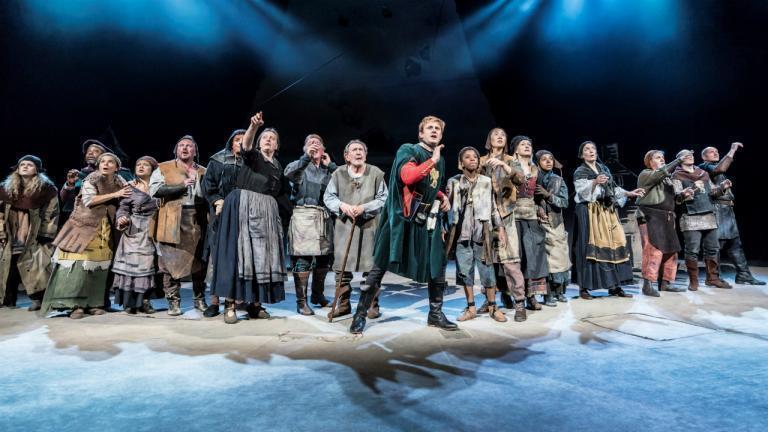 We’re greeted by a woollen-cape clad, long-haired man spouting rhyming poetry over a beating drum. He talks of his vision of an England as home, a land belonging to all. Safe, free, fair and dun filled. Those days are long gone. But George, soon to become Saint George, is here to save us.
We’re greeted by a woollen-cape clad, long-haired man spouting rhyming poetry over a beating drum. He talks of his vision of an England as home, a land belonging to all. Safe, free, fair and dun filled. Those days are long gone. But George, soon to become Saint George, is here to save us.
So begins a new play by Rory Mullarkey, now running at London’s National Theatre. Changing identity, hero worship, and myth making are the big themes tackled by this play. Loosely inspired by Evgeny Schwartz’s 1943 play The Dragon, a satire on the Soviet Union, the subject is now switched to England and misplaced pride in an idea of national power and prowess.
Trussed up in armour made of kitchen apparatus, our hero might be able to slay the physical dragon, but will he be able to halt the metaphorical dragon that is contained within society?
The setting moves from the early medieval days of St George’s home through to the chugging chimneys of Victorian Britain to today’s high rise buildings, and the themes of national pride stay consistent yet misplaced. A real fire breathing dragon morphs into something present in systems of productivity and efficiency, citizens worshipping at the altar of apparent progress. What was once a mythic beast becomes a ‘foul system of statutes and laws, instruments of power.’
We recognise the endless cycle of hope and despair that football offers us, and of course know how the entertainment offered by GameBoys and MegaBowls never replaces the hole that a lack of true identity offers. That drive for more and more doesn’t always leave us feeling satisfied. A dream of future progress often sees us yearning for a past where the sun always filled the sky and the fields were always green—a past which never existed.
John Hefferman as George is naïve yet compelling, and Richard Goulding as Henry, the dragon’s sidekick, convincingly complex. The set is neat, and song filled changes between acts charming.
The first half is a neat and witty allegory, but the charm and fun is lost in the final act. Whilst the question of what counts as progress runs as a continual thread throughout, the means through which the message is delivered becomes less entertaining as the play goes on. Stylistically the play has echoes of Monty Python and Blackadder, yet its length means that the humour is contains sometimes wears thin. It’s telling that my friend was ready to leave after the second act, not realising that this was just the interval.
The themes that Saint George And The Dragon addresses are important ones. The National Theatre could have taken a few more risks with their production to make their exploration as powerful as it has the potential to be.
Filed under: Theatre & Dance

Comments